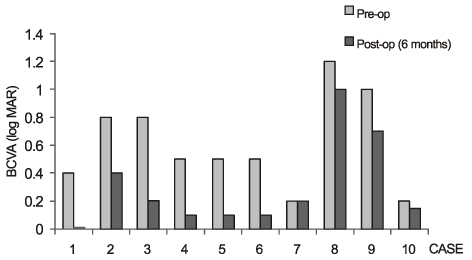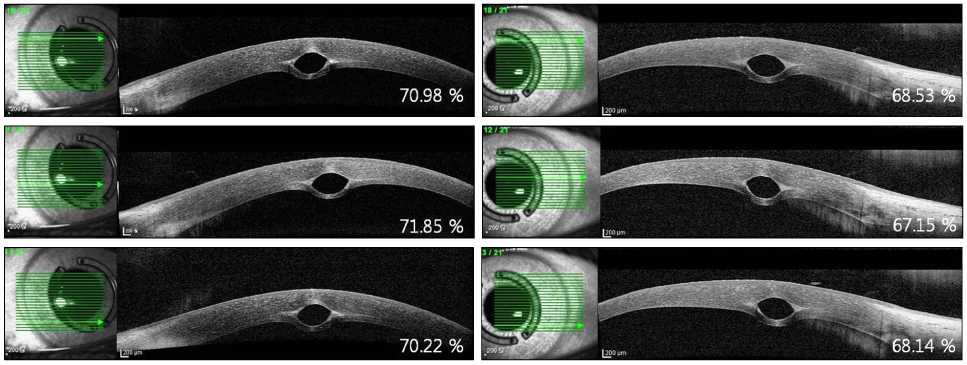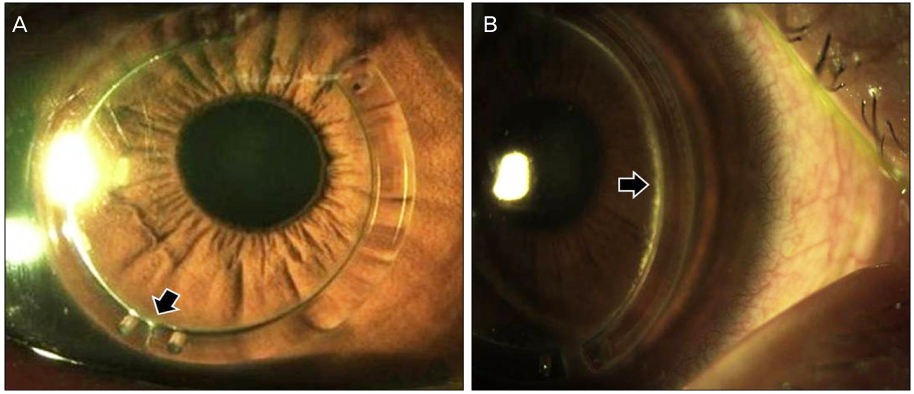J Korean Ophthalmol Soc.
2012 Dec;53(12):1756-1765. 10.3341/jkos.2012.53.12.1756.
The Clinical Results of Intacs(R) Ring Implantation by Manual Tunnel Creation in Patients with Keratoconus
- Affiliations
-
- 1Cheil Eye Hospital, Daegu, Korea. eyepark9@dreamwiz.com
- KMID: 2216387
- DOI: http://doi.org/10.3341/jkos.2012.53.12.1756
Abstract
- PURPOSE
To report the clinical results after the implantation of intrastromal corneal ring segments (Intacs(R)) by manual tunnel creation for the correction of keratoconus.
METHODS
This retrospective case series was comprised of 10 eyes of 8 consecutive keratoconic patients. Visual acuity, refractive outcome, keratometric values, anterior chamber depth, central corneal thickness, and endothelial cell density were evaluated before and at 1 month, 3 months, and 6 months postoperatively. In addition, the implanted ring segment depth was measured by anterior segment optical coherence tomography at postoperative 6 months. Any postoperative complications were also recorded.
RESULTS
Visual acuity was improved in 9 out of 10 eyes. Spherical equivalent and keratometric values were decreased in all eyes. There was no significant difference in central corneal thickness, but endothelial cell density and anterior chamber depth were slightly decreased. The depth of ring segments was almost constant at superior, middle, and inferior. There was a single case of descented implanted ring segments and 6 cases of stromal infiltration around ring segments, but visual acuity was unaffected. In addition, 1 case showed implanted ring exposure, thus the superior ring segment was removed at postoperative 4 months.
CONCLUSIONS
Intrastromal corneal ring segment implantation (Intacs(R)) by manual tunnel creation appears to be effective in improving the visual acuity and stabilizing corneal refractive power in keratoconic patients.
MeSH Terms
Figure
Reference
-
1. Krachmer JH, Feder RS, Belin MW. Keratoconus and related noninflammatory corneal thinning disorders. Surv Ophthalmol. 1984. 28:293–322.2. Rabinowitz YS. Keratoconus. Surv Ophthalmol. 1998. 42:297–319.3. Kim MK, Lee JH. Long-term outcome of graft rejection after penetrating keratoplasty. J Korean Ophthalmol Soc. 1997. 38:1553–1560.4. Kim KH, Ahn K, Chung ES, Chung TY. Comparison of deep anterior lamellar keratoplasty and penetrating keratoplasty for keratoconus. J Korean Ophthalmol Soc. 2008. 49:222–229.5. Wollensak G, Spoerl E, Seiler T. Riboflavin/ultraviolet-a-induced collagen crosslinking for the treatment of keratoconus. Am J Ophthalmol. 2003. 135:620–627.6. Lee P, Jin KH. Clinical results of riboflavin and ultraviolet-a-induced corneal cross-linking for progressive keratoconus in Korean patients. J Korean Ophthalmol Soc. 2011. 52:23–28.7. Colin J, Cochener B, Savary G, Malet F. Correcting keratoconus with intracorneal rings. J Cataract Refract Surg. 2000. 26:1117–1122.8. Siganos CS, Kymionis GD, Kartakis N, et al. Management of keratoconus with Intacs. Am J Ophthalmol. 2003. 135:64–70.9. Colin J, Malet FJ. Intacs for the correction of keratoconus: two-year follow-up. J Cataract Refract Surg. 2007. 33:69–74.10. Choi SW, Choae WS, Her J. Intrastromal corneal ring segments (Keraring®) implantation for the correction of keratoconus. J Korean Ophthalmol Soc. 2011. 52:277–284.11. Ha CI, Choi SK, Lee DH, Kim JH. The clinical results of intrastromal corneal ring segment implantation using a femtosecond laser in keratectasia. J Korean Ophthalmol Soc. 2010. 51:1–7.12. Kim HS, Lee TH, Lee KH. Intracorneal ring segment implantation for the management of keratoconus: short-term safety and efficacy. J Korean Ophthalmol Soc. 2009. 50:1505–1509.13. Ertan A, Kamburoğlu G. Intacs implantation using a femtosecond laser for management of keratoconus: Comparison of 306 cases in different stages. J Cataract Refract Surg. 2008. 34:1521–1526.14. Piñero DP, Alio JL, El Kady B, et al. Refractive and aberrometric outcomes of intracorneal ring segments for keratoconus: mechanical versus femtosecond-assisted procedures. Ophthalmology. 2009. 116:1675–1687.15. Maguire LJ, Lowry JC. Identifying progression of subclinical keratoconus by serial topography analysis. Am J Ophthalmol. 1991. 112:41–45.16. Alió JL, Shabayek MH, Belda JI, et al. Analysis of results related to good and bad outcomes of Intacs implantation for keratoconus correction. J Cataract Refract Surg. 2006. 32:756–761.17. Ruckhofer J, Twa MD, Schanzlin DJ. Clinical characteristics of lamellar channel deposits after implantation of intacs. J Cataract Refract Surg. 2000. 26:1473–1479.18. Rodrigues MM, McCarey BE, Waring GO 3rd, et al. Lipid deposits posterior to impermeable intracorneal lenses in rhesus monkeys: clinical, histochemical, and ultrastructural studies. Refract Corneal Surg. 1990. 6:32–37.19. Coskunseven E, Jankov MR 2nd, Hafezi F, et al. Effect of treatment sequence in combined intrastromal corneal rings and corneal collagen crosslinking for keratoconus. J Cataract Refract Surg. 2009. 35:2084–2091.
- Full Text Links
- Actions
-
Cited
- CITED
-
- Close
- Share
- Similar articles
-
- Intracorneal Ring Segment Implantation for the Management of Keratoconus: Short-Term Safety and Efficacy
- Intrastromal Corneal Ring Segments (KeraRing(R)) Implantation for the Correction of Keratoconus
- Clinical Results of Intacs(R) Ring Implantation in Keratoconus or Keratectasia
- A Case of Fungal Keratitis after Intracorneal Ring Segment Implantation for Keratoconus
- Sequential Intrastromal Corneal Ring Implantation and Cataract Surgery in a Severe Keratoconus Patient with Cataract






